The Influence of the Middle East Respiratory Syndrome Outbreak on Online and Offline Markets for Retail Sales
Abstract
:1. Introduction
2. Literature Review and Research Framework
2.1. Literature Review
2.2. Middle East Respiratory Syndrom (MERS) Outbreak and Its Prevention Efforts
2.3. Research Framework and Hypothesis
3. Materials and Methods
3.1. Data and Classification
3.2. Methodology and Research Process
3.3. Models
4. Results
4.1. Electronic Goods
4.2. Semi-Luxury Goods
4.3. Grocery Goods
5. Discussion
6. Conclusions
Acknowledgments
Author Contributions
Conflicts of Interest
Appendix A. Decomposition of Retail Sales by Offline and Online Goods
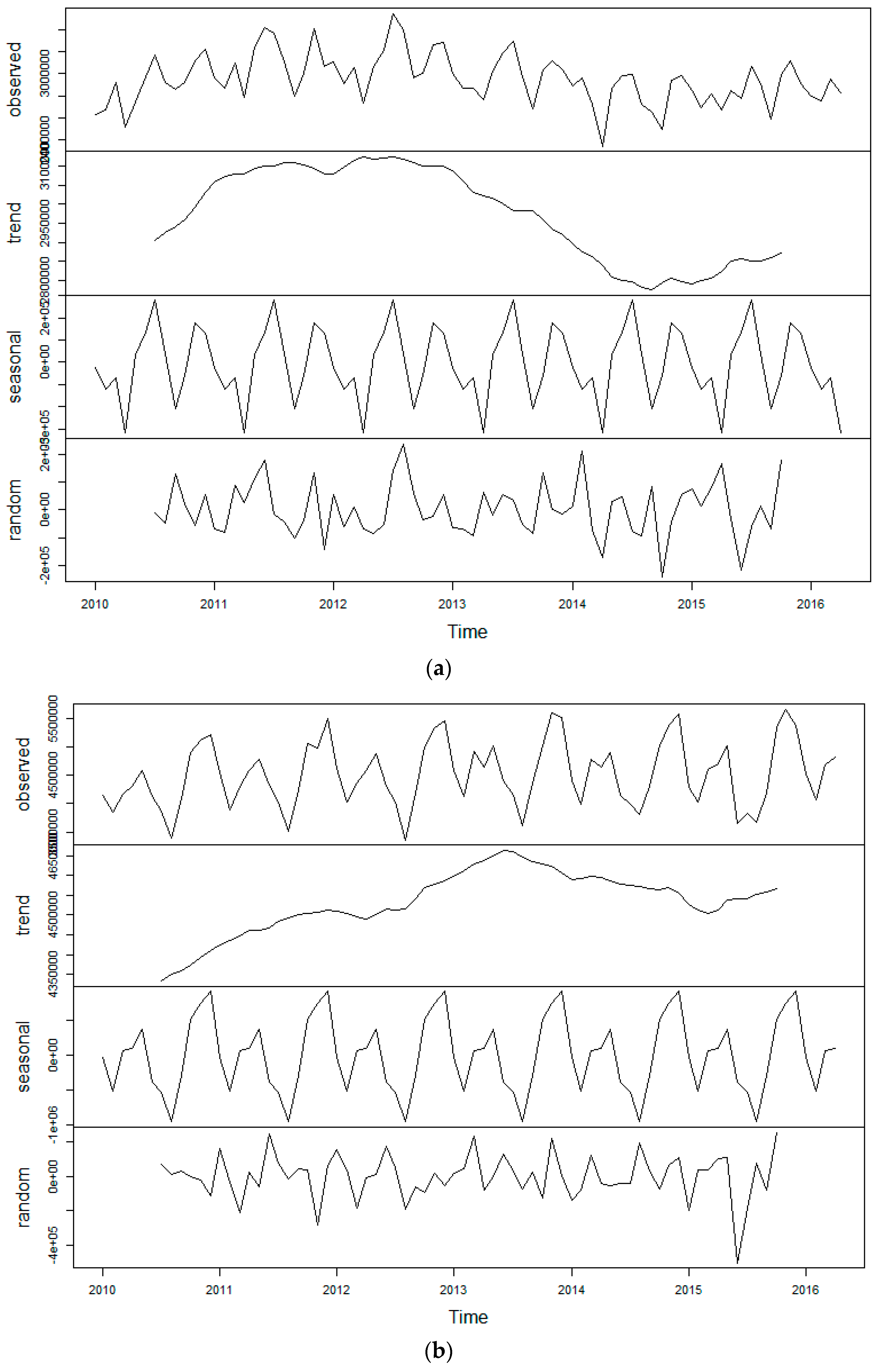
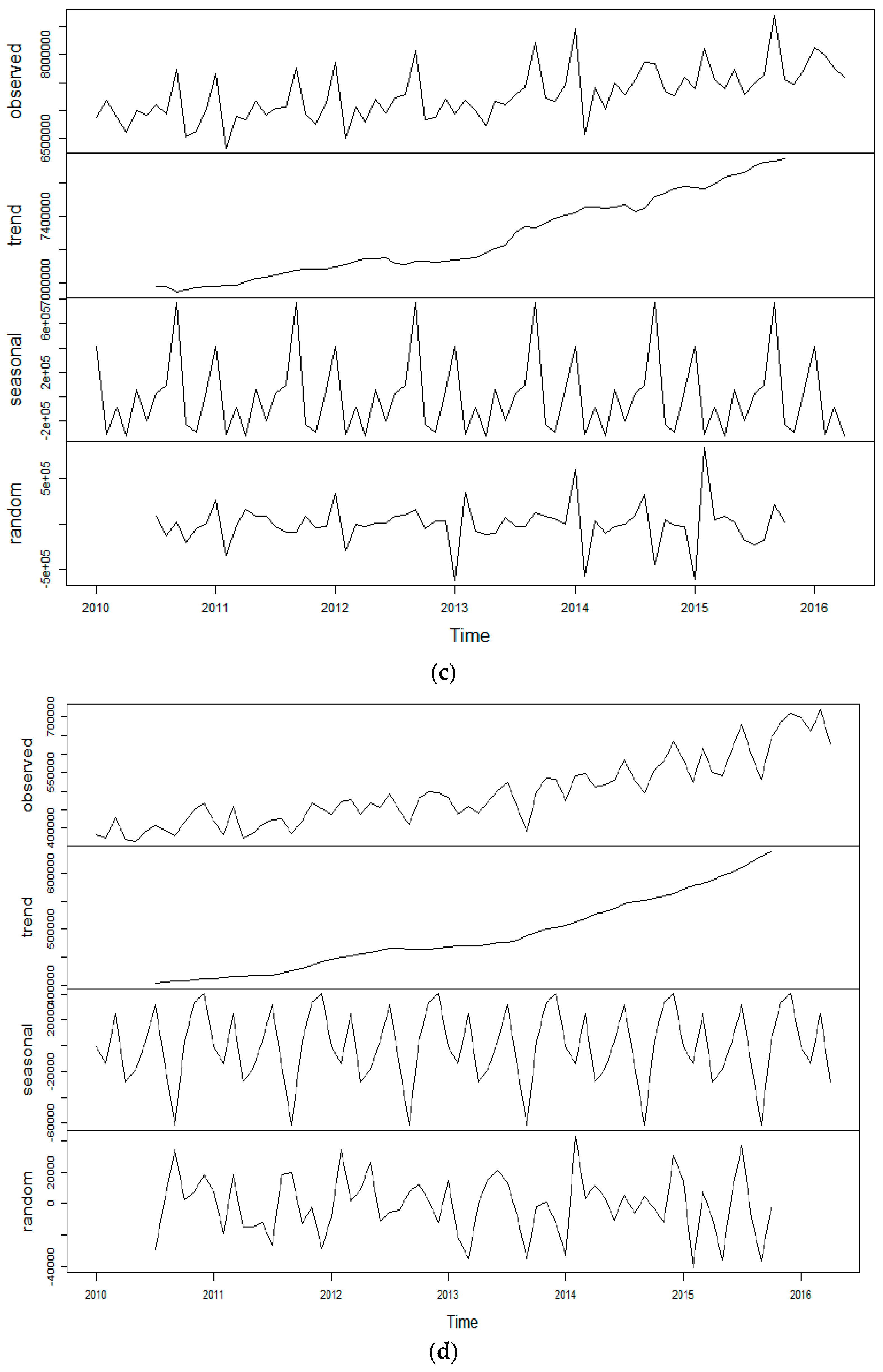
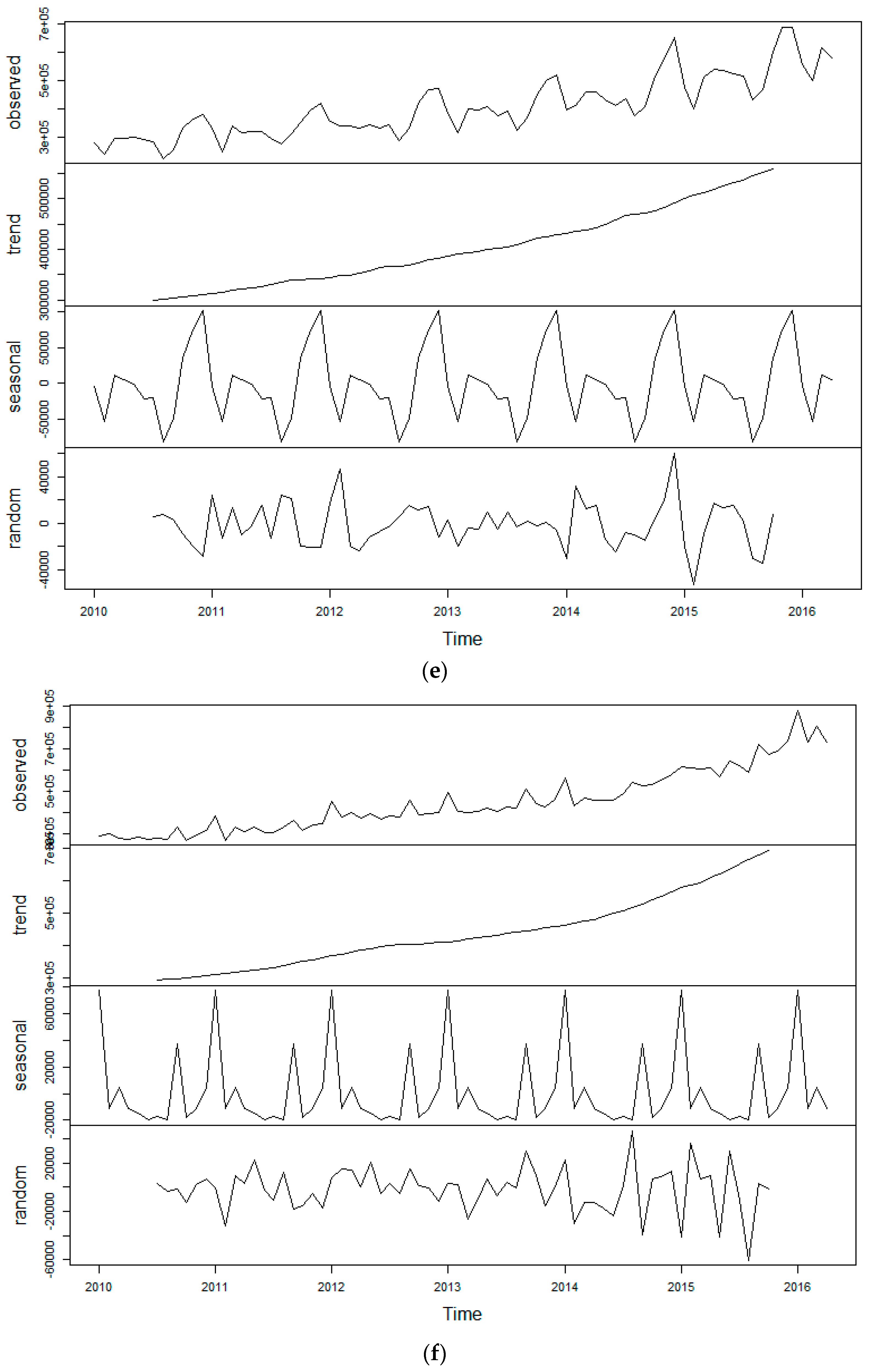
Appendix B. Monthly Comparison of Retail Sales for the Same Months of 2014 and 2015
| January | February | March | April | May | June | July | August | September | October | November | December | |||
|---|---|---|---|---|---|---|---|---|---|---|---|---|---|---|
| Electronic goods | offline | 2014 | 2888.7 | 2962.6 | 2720.3 | 2346.7 | 2873.6 | 2985.5 | 2998.8 | 2729.0 | 2652.2 | 2493.0 | 2942.1 | 2985.8 |
| 2015 | 2846.0 | 2693.2 | 2819.1 | 2670.9 | 2852.9 | 2777.1 | 3071.2 | 2907.4 | 2586.2 | 2991.2 | 3115.7 | 2906.9 | ||
| Change (%) | −1.48 | −9.09 | 3.63 | 13.81 | −0.72 | −6.98 | 2.41 | 6.54 | −2.49 | 19.98 | 5.90 | −2.64 | ||
| online | 2014 | 473.4 | 541.7 | 547.6 | 509.6 | 516.2 | 530.8 | 583.1 | 527.8 | 494.7 | 556.9 | 580.8 | 634.1 | |
| 2015 | 584.3 | 523.7 | 615.1 | 549.6 | 541.7 | 614.3 | 679.9 | 596.5 | 533.3 | 640.0 | 686.0 | 709.2 | ||
| Change (%) | 23.42 | −3.32 | 12.32 | 7.84 | 4.94 | 15.73 | 16.60 | 13.02 | 7.81 | 14.91 | 18.13 | 11.83 | ||
| Semi−luxury goods | offline | 2014 | 4412.4 | 3989.6 | 4776.5 | 4646.3 | 4906.4 | 4144.4 | 3997.6 | 3804.9 | 4307.3 | 5013.4 | 5389.3 | 5582.4 |
| 2015 | 4295.6 | 4033.8 | 4601.5 | 4710.2 | 5024.9 | 3647.8 | 3824.9 | 3668.1 | 4187.2 | 5342.8 | 5669.4 | 5385.4 | ||
| Change (%) | −2.65 | 1.11 | −3.66 | 1.38 | 2.42 | −11.98 | −4.32 | −3.60 | −2.79 | 6.57 | 5.20 | −3.53 | ||
| online | 2014 | 396.2 | 415.1 | 463.1 | 463.1 | 434.2 | 411.5 | 438.2 | 377.2 | 407.8 | 515.8 | 577.9 | 654.2 | |
| 2015 | 477.2 | 401.8 | 513.5 | 540.0 | 538.5 | 525.5 | 518.7 | 432.4 | 470.8 | 601.8 | 690.8 | 690.2 | ||
| Change (%) | 20.42 | −3.21 | 10.87 | 16.59 | 24.03 | 27.70 | 18.36 | 14.65 | 15.45 | 16.68 | 19.54 | 5.50 | ||
| Groceries | offline | 2014 | 8450.7 | 6575.9 | 7403.9 | 7019.6 | 7492.1 | 7275.8 | 7556.8 | 7866.2 | 7842.2 | 7355.6 | 7260.7 | 7600.2 |
| 2015 | 7386.1 | 8104.7 | 7554.8 | 7397.0 | 7740.6 | 7292.5 | 7495.7 | 7637.6 | 8713.6 | 7542.6 | 7473.8 | 7742.2 | ||
| Change (%) | −12.60 | 23.25 | 2.04 | 5.38 | 3.32 | 0.23 | −0.81 | −2.91 | 11.11 | 2.54 | 2.93 | 1.87 | ||
| online | 2014 | 562.1 | 429.3 | 468.2 | 457.2 | 458.4 | 455.3 | 490.4 | 543.4 | 527.2 | 529.8 | 550.3 | 581.0 | |
| 2015 | 613.8 | 610.0 | 606.6 | 607.8 | 565.4 | 642.5 | 622.9 | 587.1 | 719.5 | 673.8 | 687.9 | 737.3 | ||
| Change (%) | 9.20 | 42.09 | 29.56 | 32.94 | 23.34 | 41.10 | 27.01 | 8.03 | 36.47 | 27.18 | 25.00 | 26.90 | ||
References
- Wang, Q.; Song, P.; Yang, X. Understanding the substitution effect between online and traditional channels: Evidence from product attributes perspective. Electron. Mark. 2013, 23, 227–239. [Google Scholar] [CrossRef]
- Kim, J.W. Impact of Electronic Commerce Growth on Traditional Retail Store. Unpublished Master’s Thesis, Hanyang University, Seoul, Korea, 2002. [Google Scholar]
- Jung, E.A.; Sung, H.G. The effects of homogeneous and heterogeneous Spatial Clustering characteristics on retail sales in Seoul. J. Korea Plan. Assoc. 2016, 51, 63–83. [Google Scholar] [CrossRef]
- Weltevreden, J.W.J. Substitution or complementarity? How the internet changes city centre shopping. J. Retail. Consum. Serv. 2007, 14, 192–207. [Google Scholar] [CrossRef]
- Kim, T.H.; Lee, H.H. Considerations left behind Middle East respiratory syndrome coronavirus (MERS-CoV) outbreaks in Republic of Korea. J. Menopausal Med. 2015, 21, 63–64. [Google Scholar] [CrossRef] [PubMed]
- Kim, W.J. A study on the impact of the epidemic disease on number of books checked out of the public libraries: Based on the Middle East Respiratory Syndrome Coronavirus. J. Korean Soc. Inf. Manag. 2015, 32, 273–287. [Google Scholar] [CrossRef]
- Wang, K.Y. How change of public transportation usage reveals fear of the SARS virus in a city. PLoS ONE 2014, 9, e89405. [Google Scholar] [CrossRef] [PubMed]
- Deleersnyder, B.B.; Dekimpe, M.G.; Sarvary, M.; Parker, P.M. Weathering tight economic times: The sales evolution of consumer durables over the business cycle. Quant. Mark. Econ. 2004, 2, 347–383. [Google Scholar] [CrossRef]
- Jung, H.J.; Park, M.J.; Hong, K.H.; Hyun, E.J. The impact of an epidemic outbreak on consumer expenditures: An empirical assessment for MERS Korea. Sustainability 2016, 8, 454. [Google Scholar] [CrossRef]
- KEIT. Available online: http://www.kiet.re.kr/kiet_web/?sub_num=9&state=view&idx=51116 (accessed on 12 August 2016).
- Chien, G.C.; Law, R. The impact of the Severe Acute Respiratory Syndrome on hotels: A case study of Hong Kong. Int. J. Hosp. Manag. 2003, 22, 327–332. [Google Scholar] [CrossRef]
- Moon, J.H.; Han, S.L. Analysis of the influence of MERS epidemic on the retailing industry of Seoul City. J. Channel Retail. 2016, 21, 129–152. [Google Scholar]
- Bloom, D.E.; Mahal, A.S. Does the AIDS epidemic threaten economic growth? J. Econometr. 1997, 77, 105–124. [Google Scholar] [CrossRef]
- Taylor, J.B. Analysis of Daily Sales Data during the Financial Panic of 2008. Unpublished work. 2009. Available online: https://pdfs.semanticscholar.org/8698/8d998dae1a2b52e44aa6189353e5a28600e9.pdf (accessed on 16 June 2016).
- Kim, S.Y.; Seong, B.C. Intervention analysis of Korea tourism data. Korean J. Appl. Stat. 2011, 24, 735–743. [Google Scholar] [CrossRef]
- Kilcourse, B.; Rowen, S. Finding the Integrated Multichannel Retailer; Retail Systems Research: Miami, FL, USA, 2008. [Google Scholar]
- Sung, H. Impacts of the Outbreak and Proliferation of the Middle East Respiratory Syndrome on Rail Transit Ridership in the Seoul Metropolitan City. J. Korea Plan. Assoc. 2016, 51, 163–179. [Google Scholar] [CrossRef]
- Kim, C.; Cheon, S.H.; Seong, H.M.; Hwang, J.; Choi, K.; Joh, C.H. Exposure to fear: An analysis of behavioral change under MERS spread in Seoul. In Proceedings of the Transportation Research Board 95th Annual Meeting, Washington, DC, USA, 14 January 2016.
- Sung, H.; Kwak, M. Mediation Impacts of Physical Urban Form on Rail Transit Ridership by the Infection Fear of the Middle East Respiratory Syndrome: Focused on the Rail Station Area in Seoul, Korea. J. Korean Plann. Assoc. 2016, 51, 165–180. [Google Scholar] [CrossRef]
- Zwart, O.; Veldhuijzen, I.K.; Elam, G.; Arja, A.R.; Abraham, T.; Bishop, G.D.; Richardus, J.H.; Brug, J. Avian Influenza Risk Perception, Europe and Asia. Emerg. Infect. Dis. 2007, 13, 290–293. [Google Scholar] [CrossRef] [PubMed]
- Sands, P.; Mundaca-Shah, C.; Dzau, V.J. The neglected dimension of global security—A framework for countering infectious-disease crises. N. Engl. J. Med. 2016, 374, 1281–1287. [Google Scholar] [CrossRef] [PubMed]
- Chi, J.; Baek, J.L.J.; Werner, R. The macroeconomic effects of a pandemic in Europe—A model-based assessment. Eur. Comm. Econ. Pap. 2006. [Google Scholar] [CrossRef]
- Galbraith, J.W.; Tkacz, G. Analyzing economic effects of September 11 and other extreme events using debit and payments system data. Can. Public Policy 2013, 39, 119–134. [Google Scholar] [CrossRef]
- Zhang, G.; Wei, X. The Impact of SARS on China’s Tourism Industry and the Recovery Strategy; Social Science Documentation Publishing House: Beijing, China, 2003. [Google Scholar]
- Wen, Z.; Huimin, G.; Kavanaugh, R.R. The impacts of SARS on the consumer behaviour of Chinese domestic tourists. Curr. Issues Tour. 2005, 8, 22–38. [Google Scholar] [CrossRef]
- Liu, Y.V.; Massare, M.J.; Barnard, D.L.; Kort, T.; Nathan, M.; Wang, L.; Smith, G. Chimeric severe acute respiratory syndrome coronavirus (SARS-CoV) S glycoprotein and influenza matrix 1 efficiently form virus-like particles (VLPs) that protect mice against challenge with SARS-CoV. Vaccine 2011, 29, 6606–6613. [Google Scholar] [CrossRef] [PubMed]
- Chi, J.; Baek, J. Dynamic relationship between air transport demand and economic growth in the United States: A new look. Transp. Policy 2013, 29, 257–260. [Google Scholar] [CrossRef]
- Lee, J.W.; McKibbin, W.J. Estimating the global economic costs of SARS. In Learning from SARS: Preparing for the Next Disease Outbreak—Workshop Summary; National Academy of Sciences: Washington, DC, USA, 2004. [Google Scholar]
- Siu, A.; Wong, Y.R. Economic impact of SARS: The case of Hong Kong. Asian Econ. Pap. 2004, 3, 62–83. [Google Scholar] [CrossRef] [Green Version]
- Fenichel, E.P.; Kuminoff, N.V.; Chowell, G. Skip the trip: Air Travelers’ behavioral responses to pandemic influenza. PLoS ONE 2013, 8, e58249. [Google Scholar] [CrossRef] [PubMed]
- Jonung, L.; Roeger, W. The macroeconomic effects of a pandemic in Europe-A model-based assessment. SSRN Electron. J. 2006. [Google Scholar] [CrossRef]
- Rittichainuwat, B.N.; Chakraborty, G. Perceived travel risks regarding terrorism and disease: The case of Thailand. Tour. Manag. 2009, 30, 410–418. [Google Scholar] [CrossRef]
- D’Arpizio, C. World Luxury Markets Monitor: 2015 Spring Update; Bain & Company: Milan, Italy, 2015. [Google Scholar]
- Ryu, G.H. Harm and future works on tourism by MERS outbreak. Korea Tour. Policy 2015, 9, 8–17. [Google Scholar]
- Hanna, D.; Huang, Y. The impact of SARS on Asian economies. Asian Econ. Pap. 2004, 3, 102–112. [Google Scholar] [CrossRef]
- Durai, P.; Batool, M.; Shah, M.; Choi, S. Middle East respiratory syndrome coronavirus: Transmission, virology and therapeutic targeting to aid in outbreak control. Exp. Mol. Med. 2015, 47, e181. [Google Scholar] [CrossRef] [PubMed]
- Balkhair, A.; Maamari, K.A.; Alawi, F.B. The struggle against MERS-CoV (The novel coronavirus). Oman Med. J. 2013, 28, 226–227. [Google Scholar] [CrossRef] [PubMed]
- Tambo, E.; Oljira, T.; Oluwasogo, O.A.; Khater, E.M.; Xiao-Non, Z. Averting MERS-Cov emerging threat and epidemics: The importance of community alertness and preparedness policies and programs. J. Prev. Infect. Control 2015, 1, 1–6. [Google Scholar] [CrossRef]
- The Seoul City Government. White Paper for Prevention on the Middle East Respiratory Syndrome Coronavirus; Seoul city: Seoul, Korea, 2015. [Google Scholar]
- Higgins, E.T. Beyond pleasure and pain. Am. Psychol. 1997, 52, 1280–1300. [Google Scholar] [CrossRef] [PubMed]
- Freud, A. The Ego and the Mechanisms of Defense; Hogarth Press: New York, NY, USA, 1936. [Google Scholar]
- Werth, L.; Foerster, J. How regulatory focus influence consumer behavior. Eur. J. Soc. Psychol. 2007, 37, 33–51. [Google Scholar] [CrossRef]
- Moussaïd, M. Opinion formation and the collective dynamics of risk perception. PLoS ONE 2013, 8, e84592. [Google Scholar] [CrossRef] [PubMed]
- Vaillant, G.E. The historical origins of Sigmund Freud’s concept of the mechanisms of defense. In Ego Mechanisms of Defense: A Guide for Clinicians and Researchers; American Psychiatric Association Press: Washington, DC, USA, 1992; pp. 3–28. [Google Scholar]
- Cramer, P. Protecting the Self: Defense Mechanisms in Action; Guilford Press: New York, NY, USA, 2006. [Google Scholar]
- Choi, J.W.; Jeon, Y.S.; Na, J.Y. A Study on the Expanded Consumer Roles in IT Environment. Consum. Policy Educ. Rev. 2015, 11, 55–78. [Google Scholar] [CrossRef]
- Dhar, R.; Wertenbroch, K. Consumer choice between hedonic and utilitarian goods. J. Mark. Res. 2000, 37, 60–71. [Google Scholar] [CrossRef]
- Levin, A.M.; Levin, I.R.; Heath, C.E. Product category dependent consumer preferences for online and offline shopping features and their influence on multi-channel retail alliances. J. Electron. Comm. Res. 2003, 4, 85–93. [Google Scholar]
- Chellappa, R.K. Consumers’ Trust in Electronic Commerce Transactions: The Role of Perceived Privacy and Perceived Security. Available online: http://www.bus.emory.edu/ram/papers/sec-priv.pdf (accessed on 17 November 2016).
- Singh, N.; Yadav, M.; Sahu, O. Consumer acceptance of apparel e-commerce—Ethiopia. Intell. Econ. 2016, 10, 55–62. [Google Scholar] [CrossRef]
- Juaneda-Ayensa, E.; Mosquera, A.; Murillo, Y.S. Omnichannel Customer Behavior: Key Drivers of Technology Acceptance and Use and Their Effects on Purchase Intention. Front. Psychol. 2016. [Google Scholar] [CrossRef] [PubMed]
- Escobar-Rodríguez, T.; Carvajal-Trujillo, E. Online purchasing tickets for low cost carriers: An application of the unified theory of acceptance and use of technology (UTAUT) model. Tour. Manag. 2014, 43, 70–88. [Google Scholar] [CrossRef]
- Levin, A.M.; Levin, I.P.; Weller, J.A. A multi-attribute analysis of preferences for online and offline shopping: Differences across products, consumers, and shopping stages. J. Electron. Comm. Res. 2005, 6, 281. [Google Scholar]
- Girard, T.; Silverblatt, R.; Korgaonkar, P. Influence of product class on preference for shopping on the internet. J. Comput. Med. Commun. 2002, 8. [Google Scholar] [CrossRef]
- Darby, M.R.; Karni, E. Free competition and the optimal amount of fraud. J. Law Econ. 1973, 16, 67–88. [Google Scholar] [CrossRef]
- Rosa, J.A.; Malter, A.J. E-(embodied) knowledge and e-commerce: How physiological factors affect online sales of experiential products. J. Consum. Psychol. 2003, 13, 63–73. [Google Scholar] [CrossRef]
- Klein, L.R. Evaluating the potential of interactive media through a new lens: Search versus experience goods. J. Bus. Res. 1998, 41, 195–203. [Google Scholar] [CrossRef]
- Weathers, D.; Sharma, S.; Wood, S.L. Effects of online communication practices on consumer perceptions of performance uncertainty for search and experience goods. J. Retail. 2007, 83, 393–401. [Google Scholar] [CrossRef]
- Bloch, P.H.; Richins, M.L. A theoretical model for the study of product importance perceptions. J. Mark. 1983, 47, 69–81. [Google Scholar] [CrossRef]
- Nelson, P. Information and consumer behavior. J. Political Econ. 1970, 78, 311–329. [Google Scholar] [CrossRef]
- Nelson, P. Advertising as information. J. Political Econ. 1974, 82, 729–754. [Google Scholar] [CrossRef]
- Brucks, M.; Zeithaml, V.A.; Naylor, G. Price and brand name as indicators of quality dimensions for consumer durables. J. Acad. Mark. Sci. 2000, 28, 359–374. [Google Scholar] [CrossRef]
- Hsieh, Y.C.; Chiu, H.C.; Chiang, M.Y. Maintaining a committed online customer: A study across search-experience-credence products. J. Retail. 2005, 81, 75–82. [Google Scholar] [CrossRef]
- Zeithaml, V.A.; Bitner, M.J.; Gremier, D.D. Service Marketing: Integrating Customer Focus Across The Firm-4/E, 3rd ed.; McGraw-Hill: Boston, MA, USA, 2006. [Google Scholar]
- Zaichkowsky, J.L. Measuring the involvement construct. J. Consum. Res. 1985, 12, 341–352. [Google Scholar] [CrossRef]
- Kim, Y.K. Exploratory Study on Online/Offline Conflict Based on Product Attributes: Transaction Cost Theory. Personal communication. Unpublished Master’s Thesis, Yonsei University, Seoul, Korea, 2000. [Google Scholar]
- Suh, J.C.; Youjae, Y. When brand attitudes affect the customer satisfaction-loyalty relation: The moderating role of product involvement. J. Consum. Psychol. 2006, 16, 145–155. [Google Scholar] [CrossRef]
- Asch, D. Competing in the new economy. Eur. Bus. J. 2001, 13, 119. [Google Scholar]
- Celsi, R.L.; Olson, J.C. The role of involvement in attention and comprehension processes. J. Consum. Res. 1988, 15, 210–224. [Google Scholar] [CrossRef]
- Choi, S.Y.; Choi, B.; Lee, H. Categorizing commercial products for customer oriented online retailing. Comput. Ind. Eng. 2006, 51, 90–101. [Google Scholar] [CrossRef]
- KOSIS (Korean Statistical Information Service). Available online: http://kosis.kr/ (accessed on 12 August 2016).
- Huang, P.; Lurie, N.H.; Mitra, S. Searching for experience on the web: An empirical examination of consumer behavior for search and experience goods. J. Mark. 2009, 73, 55–69. [Google Scholar] [CrossRef]
- Jarrett, J.E.; Kyper, E. ARIMA modeling with intervention to forecast and analyze Chinese stock prices. Int. J. Eng. Bus. Manag. 2011, 3, 53–58. [Google Scholar] [CrossRef]
- Son, C.H.; Baek, J.I.; Ban, Y.U.; Ha, S.R. The Effects of Mitigation Measures on Flood Damage Prevention in Korea. Sustainability 2015, 7, 16866–16884. [Google Scholar] [CrossRef]
- Chung, R.C.; Ip, W.H.; Chan, S.L. An ARIMA-intervention analysis model for the financial crisis in China’s manufacturing industry. Int. J. Eng. Bus. Manag. 2009, 1, 15–18. [Google Scholar] [CrossRef]
- Park, J.H.; Kim, H.J.; Lee, W.H. A Quantitative Analysis on Institutional Intervention Effect into Urban Transition. Adv. Sci. Technol. Lett. 2016, 140, 79–82. [Google Scholar]
- Unnikrishnan, J.; Suresh, K.K. Modelling the Impact of Government Policies on Import on Domestic Price of Indian Gold Using ARIMA Intervention Method. Int. J. Math. Math. Sci. 2016, 2016, 6382926. [Google Scholar] [CrossRef]
- Cheema, A.; Papatla, P. Relative importance of online versus offline information for Internet purchases: Product category and Internet experience effects. J. Bus. Res. 2010, 63, 979–985. [Google Scholar] [CrossRef]
- Ha, Y.W.; Ahn, S.; Lee, Y. Consumer choice among alternatives with hedonic and utilitarian attributes: The impact of choice range and mode. J. Consum. Stud. 2002, 13, 139–157. [Google Scholar]
- Ministry of Culture, Sports and Tourism. Available online: http://www.mcst.go.kr/web/s_data/research/researchList.jsp (accessed on 16 June 2016).
- Holbrook, M.B.; Hirschman, E.C. The experiential aspects of consumption: Consumer fantasies, feelings, and fun. J. Consum. Res. 1982, 9, 132–140. [Google Scholar] [CrossRef]
- Grabner-Kräuter, S.; Kaluscha, E.A. Empirical research in on-line trust: A review and critical assessment. Int. J. Hum. Comput. Stud. 2003, 58, 783–812. [Google Scholar] [CrossRef]
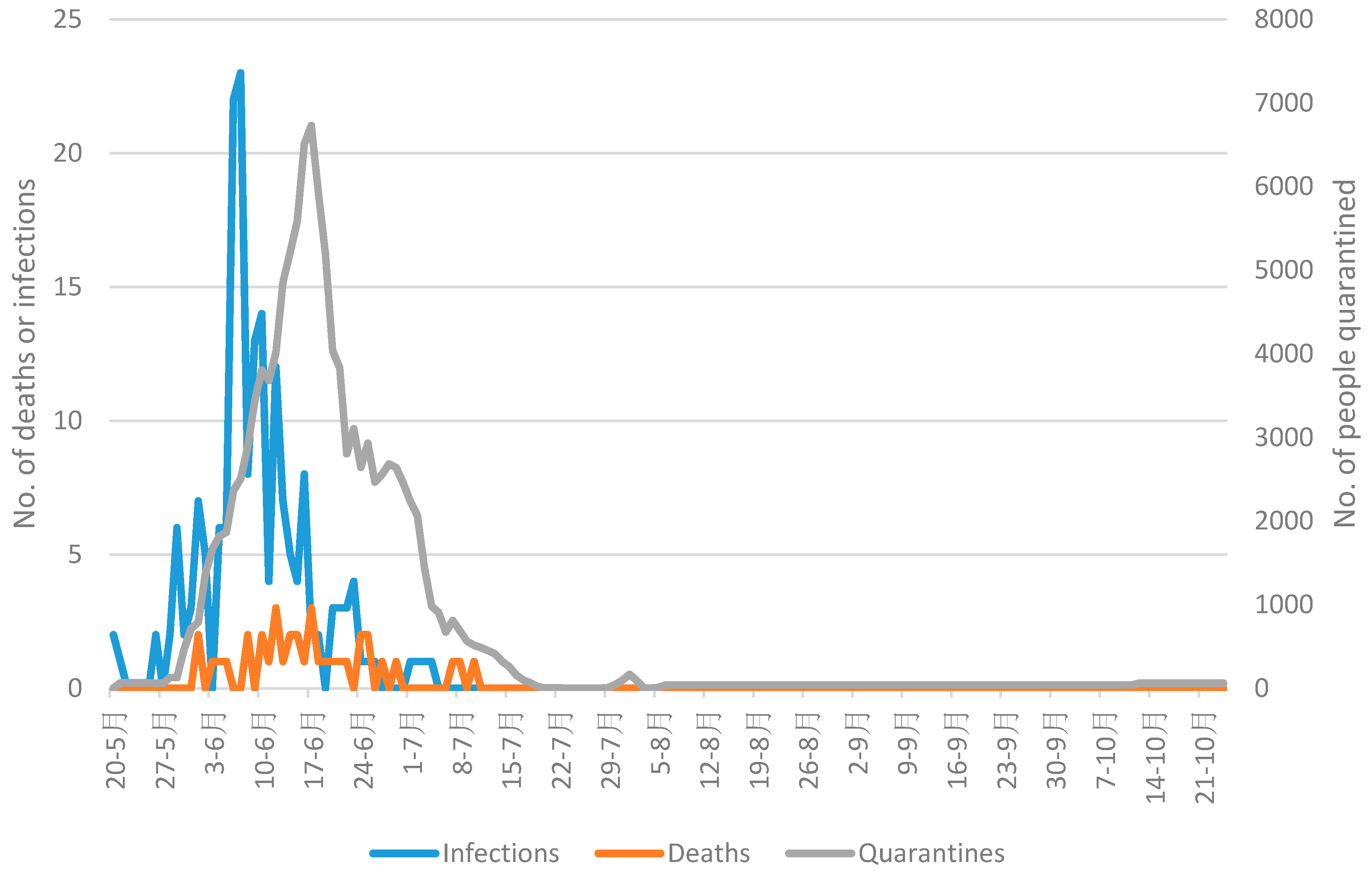


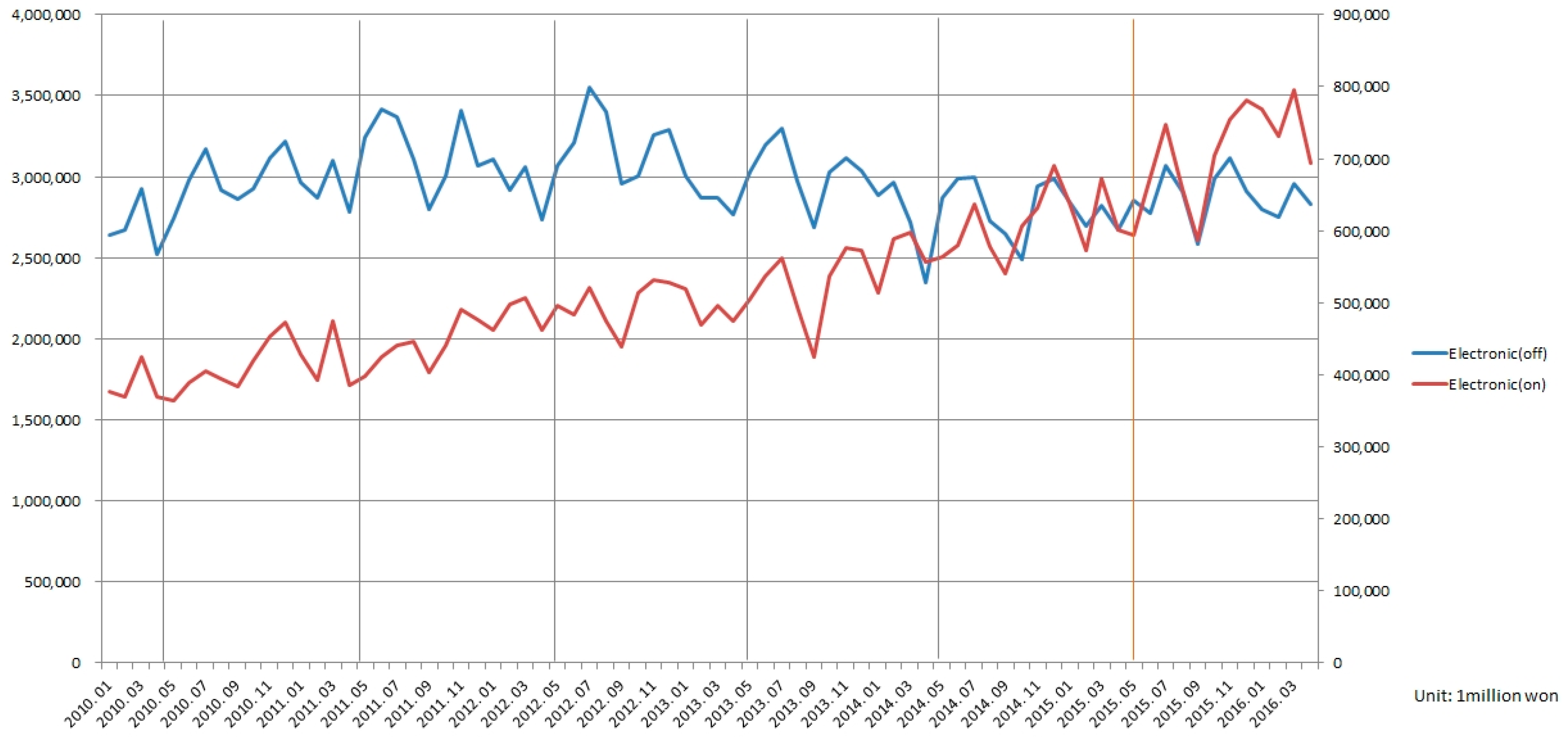
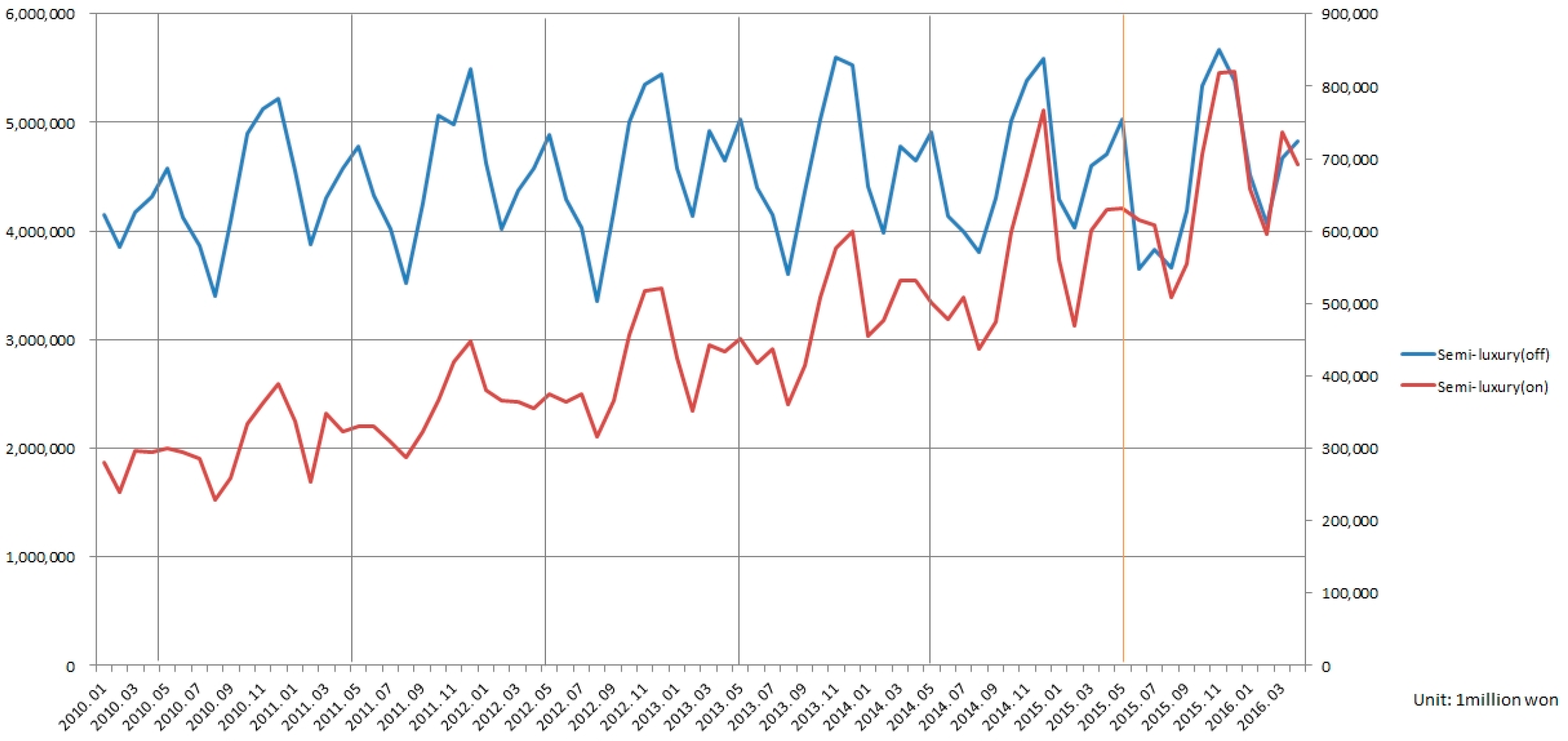
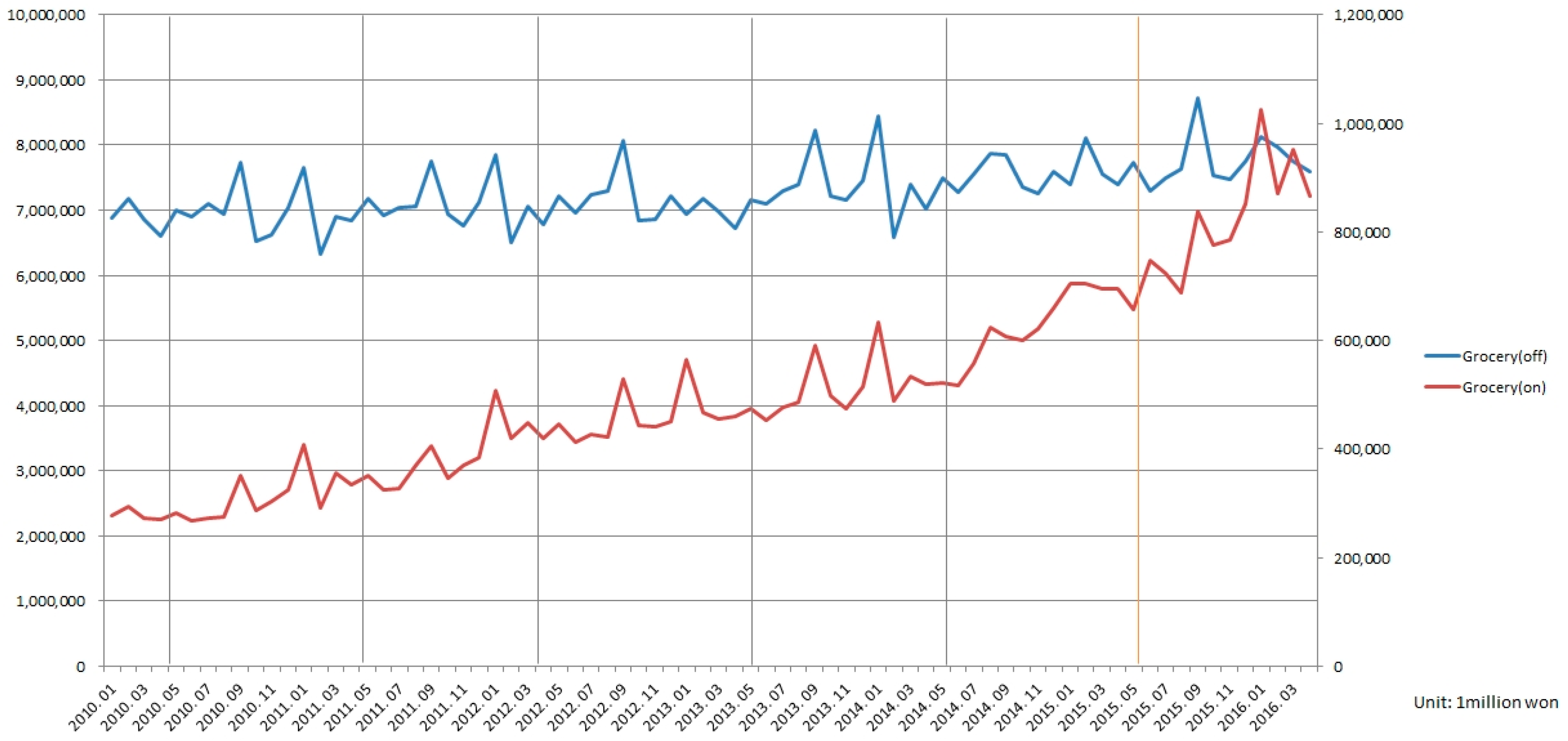
| Research | Classification Criteria | Product Categories | Examples |
|---|---|---|---|
| Darby and Karni [55] Nelson [60,61] Klein [57] Brucks et al. [62] Zeithaml and Bitner [64] Asch [68] Hsieh et al. [65] Huang et al. [72] Wang et al. [1] | Different roles of shopping orientation, standardization | Search Experience Credence | clothing and furniture vacations, telecommunications, or restaurants medical services and pension plans |
| Zaichkowsky [61] Celsi and Olson [69] Suh and Youjae [67] Wang et al. [1] | The degree of product involvement, price | High-involvement products Low-involvement products | electronic products household goods |
| KOSIS [71] | Durability, price | Durability Durable goods Non-durable goods | home appliances, communication devices and computers, furniture Clothing, shoes and bags, entertainment goods, hobbies or sports Food and beverages, medicine, cosmetics, books, and stationery |
| Kim [64] Levin et al. [53] | Buying pattern | Shopping goods Convenience goods | Clothing, home appliances Books, CDs, toothpaste |
| This study | Product involvement, standardization, durability, price, outdoor activities, utility | Electronic goods Semi-luxury goods Groceries | Home appliances and communication devices, computers Clothing, shoes, bags, accessories, etc. Food and beverages, agriculture and marine products, cosmetics |
| Offline | Online | ||||||
|---|---|---|---|---|---|---|---|
| Estimates | Standard Error | p-Value | Estimates | Standard Error | p-Value | ||
| −0.532 | 0.123 | 0.00 | −0.81 | 0.1 | 0.00 | ||
| −0.26 | 0.149 | 0.08 | −0.619 | 0.091 | 0.00 | ||
| −0.999 | 0.319 | 0.00 | 0.028 | 0.05 | 0.57 | ||
| −0.083 | 0.039 | 0.03 | 0.068 | 0.036 | 0.06 | ||
| 0.998 | 0.081 | 0.00 | |||||
| AIC | −234.76 | AIC | −181.28 | ||||
| Offline | Online | ||||||
|---|---|---|---|---|---|---|---|
| Estimates | Standard Error | p-Value | Estimates | Standard Error | p-Value | ||
| −0.62 | 0.145 | 0.00 | −0.589 | 0.117 | 0.00 | ||
| 0.88 | 0.159 | 0.00 | −0.6 | 0.108 | 0.00 | ||
| 0.335 | 0.193 | 0.09 | −0.007 | 0.047 | 0.88 | ||
| 0.546 | 0.112 | 0.00 | |||||
| 0.936 | 0.146 | 0.00 | |||||
| 0.64 | 0.182 | 0.00 | |||||
| 0.574 | 0.187 | 0.00 | |||||
| −0.16 | 0.023 | 0.00 | |||||
| −0.09 | 0.023 | 0.00 | |||||
| 0.614 | 0.021 | 0.1 | |||||
| AIC | −249.22 | AIC | −179.36 | ||||
| Offline | Online | ||||||
|---|---|---|---|---|---|---|---|
| Estimates | Standard Error | p-Value | Estimates | Standard Error | p-Value | ||
| −0.319 | 0.12 | 0.00 | −0.977 | 0.118 | 0.00 | ||
| −0.868 | 0.049 | 0.00 | −0.714 | 0.147 | 0.00 | ||
| 0.525 | 0.106 | 0.00 | −0.406 | 0.114 | 0.001 | ||
| −0.044 | 0.044 | 0.32 | 0.67 | 0.089 | 0.00 | ||
| −0.032 | 0.047 | 0.5 | |||||
| 0.788 | 0.285 | 0.00 | |||||
| AIC | −191.89 | AIC | −171.01 | ||||
© 2017 by the authors. Licensee MDPI, Basel, Switzerland. This article is an open access article distributed under the terms and conditions of the Creative Commons Attribution (CC BY) license ( http://creativecommons.org/licenses/by/4.0/).
Share and Cite
Jung, E.; Sung, H. The Influence of the Middle East Respiratory Syndrome Outbreak on Online and Offline Markets for Retail Sales. Sustainability 2017, 9, 411. https://doi.org/10.3390/su9030411
Jung E, Sung H. The Influence of the Middle East Respiratory Syndrome Outbreak on Online and Offline Markets for Retail Sales. Sustainability. 2017; 9(3):411. https://doi.org/10.3390/su9030411
Chicago/Turabian StyleJung, Eunae, and Hyungun Sung. 2017. "The Influence of the Middle East Respiratory Syndrome Outbreak on Online and Offline Markets for Retail Sales" Sustainability 9, no. 3: 411. https://doi.org/10.3390/su9030411
APA StyleJung, E., & Sung, H. (2017). The Influence of the Middle East Respiratory Syndrome Outbreak on Online and Offline Markets for Retail Sales. Sustainability, 9(3), 411. https://doi.org/10.3390/su9030411





